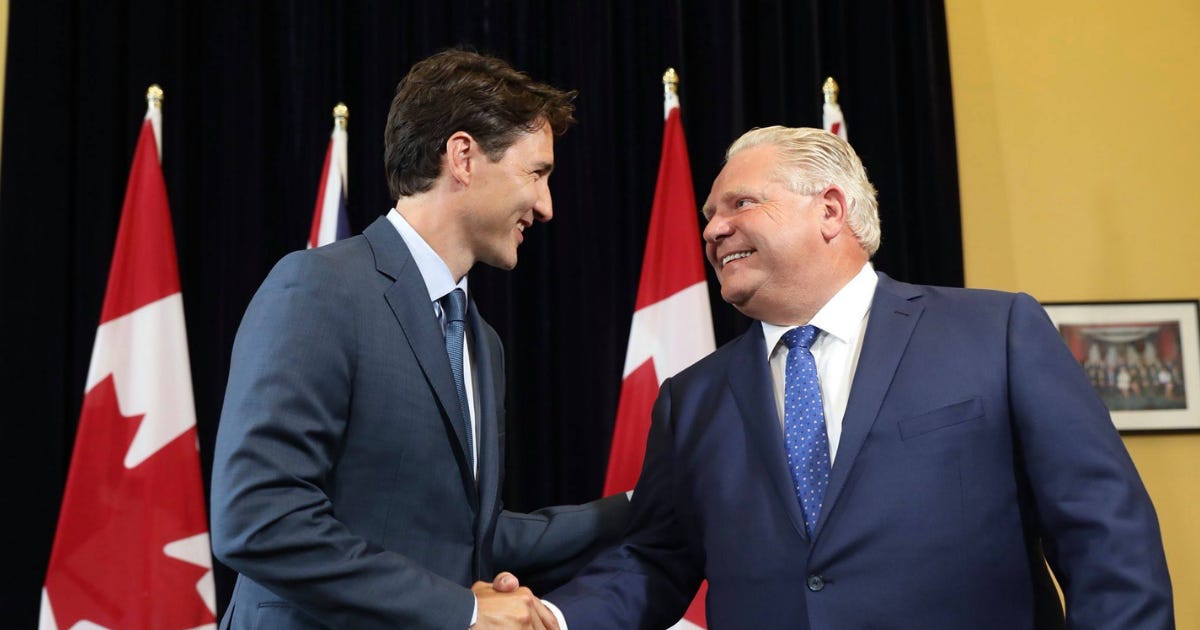Fraser Institute: Ford and Trudeau were twins when it came to fiscal management
A new Fraser Institute report reveals that former prime minister Justin Trudeau and Ontario Premier Doug Ford were practically the same when it comes to overspending, taxes, and ballooning debt.
A new Fraser Institute report reveals that former prime minister Justin Trudeau and Ontario Premier Doug Ford were practically the same when it comes to overspending, taxes, and ballooning debt, despite claiming to be on opposite sides of the political spectrum.
A report from the Fraser Institute says that the federal Liberal government and the Ontario Progressive Conservative government have governed similarly on spending and debt.
The report, titled Measuring Fiscal Policy and Fiscal Outcomes in Ontario During the Ford-Trudeau Era, found that both governments oversaw steep increases in per capita spending and tax burdens while running persistent deficits and expanding debt between 2018 and 2024.
“While Ford’s government branded itself as fiscally conservative and Trudeau’s has embraced more progressive policies, their fiscal outcomes were remarkably similar,” said Ben Eisen, senior fellow at the Fraser Institute and co-author of the report.
Federal per-person spending in Ontario rose 14 per cent in inflation-adjusted terms from 2017 to 2024, while provincial spending rose by 5.6 per cent. Combined program spending by both governments grew by 9.4 per cent per Ontarian.
Tax revenue also increased at both levels. Ottawa’s real per capita tax take from Ontarians rose by 15.2 per cent over the period, while Queen’s Park’s share grew by 5.9 per cent. Combined, taxpayers in Ontario saw a 10.4 per cent hike in the real tax burden.
The report argues the two governments largely governed in fiscal lockstep — delivering more subsidies to businesses, driving up public debt, and making little progress toward balanced budgets.
Despite Ford’s rhetoric around restraint, the report notes that Ontario continued to run deficits in most years since 2018. Meanwhile, Trudeau’s federal government posted deficits every year of the period, including a record shortfall equal to 14.8 per cent of GDP in 2020.
Debt levels surged overall. The federal net debt-to-GDP ratio rose by 10.7 points, while Ontario’s dipped slightly by 2.8 points. However, the combined federal-provincial debt burden in Ontario jumped to 82.2 per cent of GDP in 2024, up from 74.3 per cent in 2017.
Debt service costs also rose, with real per capita interest payments up 17.5 per cent, adding pressure on future budgets.
The Fraser Institute, a right-leaning think tank, said the findings challenge the notion that Ontarians receive distinct fiscal policy depending on whether they’re governed by Liberals or Conservatives.
“The outcomes speak for themselves,” Eisen said. “Despite political branding, both governments have governed in a fiscally similar way — relying on deficits, expanding debt, and taking more from taxpayers.”
The report also flags a 76 per cent increase in combined federal and provincial subsidies to businesses from 2017 to 2023, calling it an example of bipartisan support for costly corporate welfare.
Ford’s links with the Liberals extend beyond the fiscal comparison with Trudeau; he has also backed Prime Minister Mark Carney, stating he is “100 per cent supportive” of Carney and the Liberals when it comes to dealing with the U.S. tariff file.
Ford went as far as demanding that Conservative Leader Pierre Poilievre “work with the Prime Minister” only months after not endorsing Poilievre during the April election.



